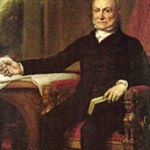Candidates:
Democratic Party: Woodrow Wilson (New Jersey) and Thomas Marshall (Indiana)
Progressive Party: Theodore Roosevelt (New York) and Hiram Johnson (California)
Republican Party: William Howard Taft (Ohio) and Nicholas Butler (New York)
Socialist Party: Eugene Debs (Indiana) and Emil Seidel (Wisconsin)
Election Results:
Wilson and Marshall: 6.29 million popular votes, 435 electoral votes.
Roosevelt and Johnson: 4.11 million popular votes, 88 electoral votes.
Taft and Butler: 3.48 million popular votes, 8 electoral votes.
Debs and Seidel: 900,000 popular votes, 0 electoral votes.
Summary:
The luster of the Taft administration was lost when its greatest supporter, Theodore Roosevelt, returned to American politics in 1910 following a year-long African safari. Roosevelt had given his support to Taft in 1908 because he wanted a continuation of his progressive policies and Taft had always been a committed, loyal worker during the Roosevelt administration. However, Taft’s administration did not go as Roosevelt had planned. The more conservative Taft did indeed continue Roosevelt’s tradition of trustbusting (actually eliminating more trusts than Roosevelt had during his seven years as president) but fired Roosevelt friend Gifford Pinchot of the United States Forestry Service and was more willing to bend on conservation policy than Roosevelt. The Pinchot incident and a series of decisions favoring trusts in 1910 led Roosevelt to spend the next two years fighting to get the presidency back. Roosevelt took every opportunity (and there were plenty, as reporters were a constant presence around him) to assault Taft’s policies and his inability to use the “bully pulpit” for a progressive agenda.
This animosity led to a vicious primary fight between Taft and Roosevelt, eliminating the tradition of sitting presidents not campaigning for primary victories. Roosevelt went into the Republican convention with more primary wins and delegates than Taft but the current president was in charge of the Republican National Committee and a purveyor of federal jobs to Republicans, which led to a swinging of delegates to Taft. Amidst massive chaos not repeated until the 1968 Democratic convention in Chicago, Taft was nominated while Roosevelt and his delegates marched out of the convention hall and held their own meeting. The Progressive (or Bull Moose) Party was established around Roosevelt’s charismatic personality and desire to lead then nation more actively than his former friend. Roosevelt and California governor Hiram Johnson led the Progressive Party and their platform included open books on corporate practices, further destruction of trusts, women’s suffrage, and the creation of an eight-hour work day.
The Democrats could not have asked for a better political situation following the disastrous Republican convention. The Democratic Party had only held the presidency twice since the Civil War and were anxious to take advantage of this opportunity. But their convention was nearly as chaotic, with several major candidates jockeying for position. New Jersey governor Woodrow Wilson, Speaker of the House Champ Clark, and party regular William Jennings Bryan were all attempting to win the two-thirds of the party delegates required to win nomination. When the southern delegates and Tammany Hall leaders were making gains behind Clark and Oscar Underwood of Alabama, the progressive Bryan used his resources to get populists and big city politicos behind the progressive Woodrow Wilson. Though there was a mess on the Democrats’ hands for much of the convention, they came out unified and ready to take down a weakened Republican Party and a fledgling Progressive Party.
Taft’s dislike for campaigning and the Republican Party’s weakness for Roosevelt led their presidential campaign from re-election to non-factor. The Democrats and Wilson focused on Roosevelt’s ebullient campaign style and left the Republicans to die a slow death. Wilson’s New Freedom program was actually more progressive than the New Nationalism plan of Roosevelt, including a complete destruction of trusts in America and a drastic increase in corporate regulations to prevent excessive corporate malfeasance. Wilson’s composed style and eloquent speech making was to some a welcome contrast to Roosevelt’s barn storming style. The combination of Wilson’s qualifications for the presidency and the split of Republicans into two entities led to an electoral landslide for Wilson but only a 40% plurality of the popular vote. Taft and Roosevelt earned over 50% of the popular vote combined and had the Republican Party been able to stay together, there was little chance Wilson would have won the presidency. But there is some dispute about this because while they would have earned more of the popular vote, Wilson had done so well nationally that he may have been able to win the electoral majority. Nonetheless, Wilson’s New Freedom plan was in effect almost immediately after the Democrat took office.


